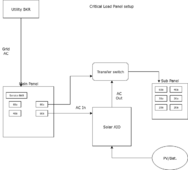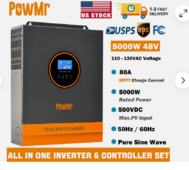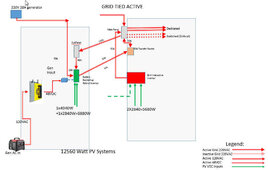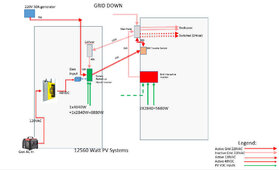LouiseSJPP
New Member
I'm wanting to install a system of maybe 3kW peak panel output, location is northern Spain.
We are grid-connected, but the solar system will be off-grid because it will be too expensive and complicated to connect it.
In summer, the power will be used to drive the air-con system, which has an electrical load of 1.5kW max, and heat domestic hot water, also 1.5kW. Air-con usage can be manually controlled, dependent on battery state.: if it's hot or humid, and we have power, we can use it The DHW would be best to be automatic, probably on a timer to limit load to mornings, when the air-con will not be on.
In winter, the power, what there is of it, will be dumped in a hot water buffer forming part of the wood-fired central heating system, thus it is not wasted. At present, the buffer has a 3kW immersion heater in it, but this can be changed to 1.5kW if needs be.
I'm thinking to cable each of these devices to a solar control panel where battery state and panel output is monitored. Each load (the two immersion heaters and the air-con) will have a flying lead at this point with a plug on the end of it, such that they can be physically plugged into the solar system or into nearby (grid-connected) wall sockets; thereby ensuring physical separation of the solar electrical system from that connected to the grid. A less elegant solution than a transfer switch or a zero-export grid-connected inverter but one which requires no proof of competence to specify and connect.
Does this sound practicable?
I should mention that I am an engineer and have wired the house myself, to local code, but have not worked with solar or other uncontrolled electrical energy sources before, so I'm a bit hesitant.
We are grid-connected, but the solar system will be off-grid because it will be too expensive and complicated to connect it.
In summer, the power will be used to drive the air-con system, which has an electrical load of 1.5kW max, and heat domestic hot water, also 1.5kW. Air-con usage can be manually controlled, dependent on battery state.: if it's hot or humid, and we have power, we can use it The DHW would be best to be automatic, probably on a timer to limit load to mornings, when the air-con will not be on.
In winter, the power, what there is of it, will be dumped in a hot water buffer forming part of the wood-fired central heating system, thus it is not wasted. At present, the buffer has a 3kW immersion heater in it, but this can be changed to 1.5kW if needs be.
I'm thinking to cable each of these devices to a solar control panel where battery state and panel output is monitored. Each load (the two immersion heaters and the air-con) will have a flying lead at this point with a plug on the end of it, such that they can be physically plugged into the solar system or into nearby (grid-connected) wall sockets; thereby ensuring physical separation of the solar electrical system from that connected to the grid. A less elegant solution than a transfer switch or a zero-export grid-connected inverter but one which requires no proof of competence to specify and connect.
Does this sound practicable?
I should mention that I am an engineer and have wired the house myself, to local code, but have not worked with solar or other uncontrolled electrical energy sources before, so I'm a bit hesitant.







